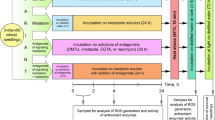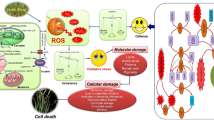Abstract
The effect of salt, pH, and temperature stress on the cellular level of antioxidant enzymes, catalase and superoxide dismutase (SOD) and glycerol-3-phosphate dehydrogenase (G3PDH) was studied in Debaryomyces nepalensis NCYC 3413, a halotolerant yeast. The catalase activity increased in different phases, while SOD and G3PDH activities declined in late stationary phase. A significant increase in SOD activity was observed under different stress as compared to control. Salt and temperature stress enhanced the catalase activity where as it was suppressed by pH stress. G3PDH level increased with salt stress, however, no significant change was observed under pH and temperature stress. The observations recorded in this investigation suggested that D. nepalensis has an efficient protective mechanism of antioxidant enzymes and G3PDH against salt, pH, and temperature stresses.




Similar content being viewed by others
References
Gummadi SN, Kumar S, Aneesh CNA (2007) Effect of salts on growth and pectinaseproduction by halotolerant yeast, Debaryomyces nepalensis NCYC 3413. Curr Microbiol 54:472–476
Kumar S, Gummadi SN (2009) Osmotic adaptation in halotolerant yeast, Debaryomyces nepalensis NCYC 3413: role of osmolytes and cation transport. Extremophiles 13:793–805
Gummadi SN, Kumar S (2008) Effects of temperature and salts on growth of halotolerant Debaryomyces nepalensis NCYC 3413. Am J Food Technol 3:354–360
Kumar S, Lal P, Gummadi SN (2008) Growth of halotolerant food spoiling yeast Debaryomyces nepalensis NCYC 3413 under the influence of pH and salt. Curr Microbiol 57:598–602
Estruch F (2000) Stress-controlled transcription factors, stress induced genes and stress tolerance in budding yeast. FEMS Microbiol Rev 24:469–486
Bandyopadhyay U, Das D, Banerjee K (1999) Reactive oxygen species: oxidative damage and pathogenesis. Curr Sci 77:658–666
Kubal BS, D’Souza SF (2004) Immobilization of catalase by entrapment of permeabilized yeast cells in hen egg white using glutaraldehyde. J Biochem Biophys Methods 59:61–64
Paoletti F, Mocali A (1990) Determination of superoxide dismutase activity by purely chemical system based on NAD(P)H oxidation. Methods Enzymol 186:209–220
Nilsson A, Adler L (1990) Purification and characterization of glycerol-3-phosphate dehydrogenase (NAD+) in the salt tolerant yeast Debaryomyces hansenii. Biochim Biophys Acta 1034:180–185
Kobayashi D, Kondo K, Uehara N, Otokozawa S, Tsuji N, Yagihashi A, Watanabe N (2002) Endogenous reactive oxygen species is an important mediator of miconazole antifungal effect. Antimicrob Agents Chemother 46:3113–3117
Talon R, Walter D, Chartier S, Barriere C, Montel MC (1999) Effect of nitrate and incubation conditions on the production of catalase and nitrate reductase by Staphylococci. Int J Food Microbiol 52:47–56
Lee DH, Kim YS, Lee CB (2001) The inductive responses of the antioxidant enzymes by salt stress in the rice (Oryza sativa L.). J Plant Physiol 158:737–745
Chao H, Yen Y, Ku MSB (2009) Characterization of a salt-induced DhAHP, a gene coding for alkyl hydroperoxide reductase, from the extremely halophilic yeast Debaryomyces hansenii. BMC Microbiol 9:182. doi:10.1186/1471-2180-9-182
Zhao J, Guo S, Chen S, Zhang H, Zhao Y (2009) Expression of yeast YAP1 in transgenic Arabidopsis results in increased salt tolerance. J Plant Biol 52:56–64
Thome PE, Trench RK (1999) Osmoregulation and the genetic induction of glycerol-3-phosphate dehydrogenase by NaCl in the euryhaline yeast Debaryomyces hansenii. Mar Biotechnol 1:230–238
Watanabe Y, Syoko T, Tamai Y (2004) Heterologous expression of Zygosaccharomyces rouxii glycerol 3-phosphate dehydrogenase gene (ZrGPD1) and glycerol dehydrogenase gene (ZrGCY1) in Saccharomyces cerevisiae. FEMS Yeast Res 4:505–510
Abrashev R, Dolashka P, Christova R, Stefanova L, Angelova M (2005) Role of antioxidant enzymes in survival of conidiospores of Aspergillus niger 26 under conditions of temperature stress. J Appl Microbiol 99:902–909
Gocheva YG, Tosi S, Krumova ET, Slokoska LS, Miteva JG, Vassilev SV, Angelova MB (2008) Temperature downshift induces antioxidant response in fungi isolated from Antarctica. Extremophiles 13:273–281
Almeselmani M, Deshmukh PS, Sairam RK, Kushwaha SR, Singh TP (2006) Protective role of antioxidant enzymes under high temperature stress. Plant Sci 171:382–388
Bettaieb T, Mahmoud M, Galarreta JIR, Du Jardin P (2007) Relation between the low temperature stress and catalase activity in gladiolus somaclones (Gladiolus grandiflorus Hort.). Sci Hortic 113:49–51
Albertyn J, Hohmann S, Thevelein JM, Prior BA (1994) GPD1, which encodes glycerol-3-phosphate dehydrogenase, is essential for growth under osmotic stress in Saccharomyces cerevisiae, and its expression is regulated by the high-osmolarity glycerol response pathway. Mol Cell Biol 14:4135–4144
Winkler A, Arkind C, Mattison CP, Burkholder A, Knoche K, Ota I (2002) Heat stress activates the yeast high-osmolarity glycerol mitogen-activated protein kinase pathway, and protein tyrosine phosphatases are essential under heat stress. Eukaryot Cell 1:163–173
Babourina O, Ozturk L, Cakmak I, Rengel Z (2006) Reactive oxygen species production in wheat roots is not linked with changes in H+ fluxes during acidic and aluminium stresses. Plant Signal Behav 1:71–76
Qing-hua S, Zhu-jun Z, Juan L, Qiong-qiu Q (2006) Combined effects of excess Mn and low pH on oxidative stress and antioxidant enzymes in cucumber roots. Agric Sci China 5:767–772
Acknowledgment
This study was supported by research grant from Department of Biotechnology, Government of India.
Author information
Authors and Affiliations
Corresponding author
Rights and permissions
About this article
Cite this article
Kumar, S., Kalyanasundaram, G.T. & Gummadi, S.N. Differential Response of the Catalase, Superoxide Dismutase and Glycerol-3-phosphate Dehydrogenase to Different Environmental Stresses in Debaryomyces nepalensis NCYC 3413. Curr Microbiol 62, 382–387 (2011). https://doi.org/10.1007/s00284-010-9717-z
Received:
Accepted:
Published:
Issue Date:
DOI: https://doi.org/10.1007/s00284-010-9717-z




